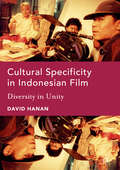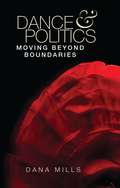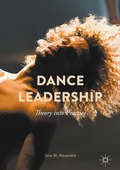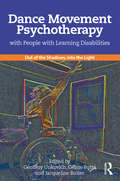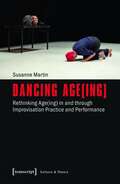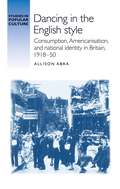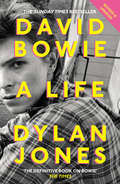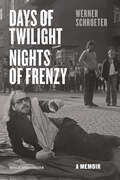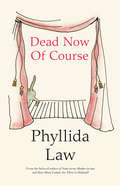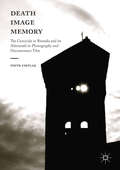- Table View
- List View
Cult Media: Re-packaged, Re-released and Restored
by Jonathan Wroot Andy WillisThis volume brings together writing on the topic of home media, and in particular releases described as appealing to ‘cult’ fans and audiences. Despite popular assumptions to the contrary, the distributors of physical media maintain a vivid presence in the digital age. Perhaps more so than any other category of film or media, this is especially the case with titles considered ‘cult’ and its related processes of distribution and exhibition. The chapters in this collection chart such uses and definitions of ‘cult’, ranging from home media re-releases to promotional events, film screenings, file-sharing and the exploitation of established fan communities. This book will be of interest to the ever-growing number of academics and research students that are specializing in studies of cult cinema and fan practices, as well as professionals (filmmakers, journalists, promoters) who are familiar with these types of films.
Cult Media: Re-packaged, Re-released and Restored
by Jonathan Wroot Andy WillisThis volume brings together writing on the topic of home media, and in particular releases described as appealing to ‘cult’ fans and audiences. Despite popular assumptions to the contrary, the distributors of physical media maintain a vivid presence in the digital age. Perhaps more so than any other category of film or media, this is especially the case with titles considered ‘cult’ and its related processes of distribution and exhibition. The chapters in this collection chart such uses and definitions of ‘cult’, ranging from home media re-releases to promotional events, film screenings, file-sharing and the exploitation of established fan communities. This book will be of interest to the ever-growing number of academics and research students that are specializing in studies of cult cinema and fan practices, as well as professionals (filmmakers, journalists, promoters) who are familiar with these types of films.
Cultural and Political Nostalgia in the Age of Terror: The Melancholic Sublime (Routledge Research in Cultural and Media Studies)
by Matthew LeggattThis book re-examines the role of the sublime across a range of disparate cultural texts, from architecture and art, to literature, digital technology, and film, detailing a worrying trend towards nostalgia and arguing that, although the sublime has the potential to be the most powerful uniting aesthetic force, it currently spreads fear, violence, and retrospection. In exploring contemporary culture, this book touches on the role of architecture to provoke feelings of sublimity, the role of art in the aftermath of destructive events, literature’s establishment of the historical moment as a point of sublime transformation and change, and the place of nostalgia and the returning of past practices in digital culture from gaming to popular cinema.
Cultural and Political Nostalgia in the Age of Terror: The Melancholic Sublime (Routledge Research in Cultural and Media Studies)
by Matthew LeggattThis book re-examines the role of the sublime across a range of disparate cultural texts, from architecture and art, to literature, digital technology, and film, detailing a worrying trend towards nostalgia and arguing that, although the sublime has the potential to be the most powerful uniting aesthetic force, it currently spreads fear, violence, and retrospection. In exploring contemporary culture, this book touches on the role of architecture to provoke feelings of sublimity, the role of art in the aftermath of destructive events, literature’s establishment of the historical moment as a point of sublime transformation and change, and the place of nostalgia and the returning of past practices in digital culture from gaming to popular cinema.
Cultural Performance: Ethnographic Approaches to Performance Studies
by Kevin Landis Suzanne MacaulayThis engaging book introduces the burgeoning and interdisciplinary field of cultural performance, offering ethnographic approaches to performance as well as looking at the aesthetics of experience and performance theory. Featuring case studies from a rich cross-section of academics, chapters explore performances from regions as far flung as Bhutan, Ethiopia, Ghana, Indonesia, Ireland, New Zealand and the USA. With cultural performances as varied as Catholic rituals, Maori ceremonies, Monster Truck rallies, musicals, theatre and singing performances, this fascinating text compares performance as art and performance as cultural expression. Ideal for students of performance or ethnography, this unique collection presents a clear framework for studying the themes, methodologies and developments of cultural performance.
Cultural Performance: Ethnographic Approaches to Performance Studies
by Kevin Landis Suzanne MacaulayThis engaging text introduces the burgeoning and interdisciplinary field of cultural performance, offering ethnographic approaches to performance as well as looking at the aesthetics of experience and performance theory. Examining cultural performance from anthropological, geographical and corporeal standpoints, this book offers many examples of the ways in which performance art and entertainment utilize cultural methods to deepen and enrich the practice. Featuring case studies from a rich cross-section of academics, chapters explore performances from regions as far flung as Bhutan, Ethiopia, Ghana, Indonesia, Ireland, New Zealand and the USA. With cultural performances as varied as Catholic rituals, Maori ceremonies, Monster Truck rallies, musicals, theatre and singing performances, this fascinating text compares performance as art and performance as cultural expression. Core reading for introductory and interdisciplinary modules on performance, this is also an ideal text for upper undergraduate and postgraduate students of performance, visual arts, cultural studies or ethnography.
Cultural Specificity in Indonesian Film: Diversity in Unity
by David HananThis book explores ways in which diverse regional cultures in Indonesia and their histories have been expressed in film since the early 1950s. It also explores underlying cultural dominants within the new nation, established at the end of 1949 with the achievement of independence from Dutch colonialism. It sees these dominants—for example forms of group body language and forms of consultation—not simply as a product of the nation, but as related to unique and long standing formations and traditions in the numerous societies in the Indonesian archipelago, on which the nation is based. Nevertheless, the book is not concerned only with past traditions, but explores ways in which Indonesian filmmakers have addressed, critically, distinctive aspects of their traditional societies in their feature films (including at times the social position of women), linking past to the present, where relevant, in dynamic ways.
Cultural Specificity in Indonesian Film: Diversity in Unity
by David HananThis book explores ways in which diverse regional cultures in Indonesia and their histories have been expressed in film since the early 1950s. It also explores underlying cultural dominants within the new nation, established at the end of 1949 with the achievement of independence from Dutch colonialism. It sees these dominants—for example forms of group body language and forms of consultation—not simply as a product of the nation, but as related to unique and long standing formations and traditions in the numerous societies in the Indonesian archipelago, on which the nation is based. Nevertheless, the book is not concerned only with past traditions, but explores ways in which Indonesian filmmakers have addressed, critically, distinctive aspects of their traditional societies in their feature films (including at times the social position of women), linking past to the present, where relevant, in dynamic ways.
Curtain of Lies: The Battle over Truth in Stalinist Eastern Europe
by Melissa FeinbergWhile the Cold War governments of Eastern Europe operated within the confines of the Soviet worldview, their peoples confronted the narratives of both East and West. From the Soviet Union and its satellites, they heard of a West dominated by imperialist warmongers and of the glorious future only Communism could bring. A competing discourse emanated from the West, claiming that Eastern Europe was a totalitarian land of captive slaves, powerless in the face of Soviet aggression. In Curtain of Lies, Melissa Feinberg conducts a timely examination into the nature of truth, using the political culture of Eastern Europe during the Cold War as her foundation. Focusing on the period between 1948 and 1956, she looks at how the "truth" of Eastern Europe was delineated by actors on both sides of the Iron Curtain. Feinberg offers a fresh interpretation of the Cold War as a shared political environment, exploring the ways in which ordinary East Europeans interacted with these competing understandings of their homeland. She approaches this by looking at the relationship between the American-sponsored radio stations broadcast across the Iron Curtain and the East European émigrés they interviewed as sources on life under Communism. Feinberg's careful analysis reveals that these parties developed mutually reinforced assumptions about the meaning of Communism, helping to create the evidentiary foundation for totalitarian interpretations of Communist rule in Eastern Europe. In bridging the geopolitical and the individual, Curtain of Lies provides a perspective that is both innovative in its methodology and indispensable to its field.
Dance and Organization: Integrating Dance Theory and Methods into the Study of Management (Routledge Studies in Management, Organizations and Society)
by Brigitte BiehlDance and Organisation is the first comprehensive work to integrate dance theory and methods into the study of management, which have developed an interest in the arts and the humanities. Dance represents dynamics and change and puts the moving body at the centre, which has been ignored and oppressed by traditional management theory. ‘Being’ a leader however also means to ‘move’ like one, and critical lessons can be learned from ballerinas and modern dancers. Leadership is a dialogue, as in the work of musicians, conductors and DJs who manage groups without words. Movement in organisational space, in a museum or a techno club can be understood as a choreography and site-specific performance. Movement also is practically used for leadership and employee development workshops and can be deployed as an organisational research method. By taking a firm interdisciplinary stance in dance studies and organisational research to explore management topics, reflecting on practitioner accounts and research projects, the book seeks to make an innovative contribution to our understanding of the moving body, generating new insights on teamwork, leadership, gender in management, organisational space, training and research methods. It comprises an important contribution to the organizational behaviour and critical management studies disciplines, and looks to push the boundaries of the academic literature.
Dance and Organization: Integrating Dance Theory and Methods into the Study of Management (Routledge Studies in Management, Organizations and Society)
by Brigitte BiehlDance and Organisation is the first comprehensive work to integrate dance theory and methods into the study of management, which have developed an interest in the arts and the humanities. Dance represents dynamics and change and puts the moving body at the centre, which has been ignored and oppressed by traditional management theory. ‘Being’ a leader however also means to ‘move’ like one, and critical lessons can be learned from ballerinas and modern dancers. Leadership is a dialogue, as in the work of musicians, conductors and DJs who manage groups without words. Movement in organisational space, in a museum or a techno club can be understood as a choreography and site-specific performance. Movement also is practically used for leadership and employee development workshops and can be deployed as an organisational research method. By taking a firm interdisciplinary stance in dance studies and organisational research to explore management topics, reflecting on practitioner accounts and research projects, the book seeks to make an innovative contribution to our understanding of the moving body, generating new insights on teamwork, leadership, gender in management, organisational space, training and research methods. It comprises an important contribution to the organizational behaviour and critical management studies disciplines, and looks to push the boundaries of the academic literature.
Dance and politics: Moving beyond boundaries (Manchester University Press Ser.)
by Dana MillsThis book examines the political power of dance, particularly its transgressive potential. Focusing on readings of dance pioneers Isadora Duncan and Martha Graham, Gumboots dancers in the gold mines of South Africa, the One Billion Rising movement, dabke in Palestine and dance as a protest against human rights abuse in Israel, it explores moments in which the form succeeds in transgressing politics as articulated in words. Close readings and critical analysis grounded in radical democratic theory combine to show how reading political dance as 'interruption' can unsettle conceptions of both politics and dance.
Dance Leadership: Theory Into Practice
by Jane M. AlexandreThis “what is”—rather than “how to”— volume proposes a theoretical framework for understanding dance leadership for dancers, leaders, and students of both domains, illustrated by portraits of leaders in action in India, South Africa, UK, US, Brazil and Canada. What is dance leadership? Who practices it, in what setting, and why? Through performance, choreography, teaching, writing, organizing and directing, the dance leaders portrayed herein instigate change and forward movement. Illustrating all that is unique about leading in dance, and by extension the other arts, readers can engage with such wide-ranging issues as: Does the practice of leading require followers? How does one individual’s dance movement act on others in a group? What does ‘social engagement’ mean for artists? Is the pursuit of art and culture a human right?
Dance Movement Psychotherapy with People with Learning Disabilities: Out Of The Shadows, Into The Light
by Geoffery Unkovich Céline Butté Jacqueline ButlerThis book provides an overview of dance movement psychotherapy for young people and adults with learning disabilities. Contributors from a variety of backgrounds examine their work with clients from across the disabilities spectrum, ranging from mild to complex needs. The book chapters present theory and practice relating to the client group and subsequent therapy processes. This comprises psychotherapeutic interventions, dance movement interventions, theoretical constructs, case study material, practitioner care, and practitioner learning and development related to individual and group therapy work. The logistics of a Dance Movement Psychotherapy intervention, the intervention itself and the ripples of influence into the clients’ wider socio-cultural context are discussed. This stance speaks to current research and practice discourse in health and social care. The book champions acceptance of difference and equality in the health and social care needs for people with learning disabilities whilst emphasising the importance of dance movement psychotherapy for people with non-verbal communication. Dance Movement Psychotherapy with People with Learning Disabilities: Out of the Shadows, into the Light will provide a practical and theoretical resource for practitioners and students of dance movement psychotherapy as well as allied health professionals, service providers and carers.
Dance Movement Psychotherapy with People with Learning Disabilities: Out Of The Shadows, Into The Light
by Geoffery Unkovich Céline Butté Jacqueline ButlerThis book provides an overview of dance movement psychotherapy for young people and adults with learning disabilities. Contributors from a variety of backgrounds examine their work with clients from across the disabilities spectrum, ranging from mild to complex needs. The book chapters present theory and practice relating to the client group and subsequent therapy processes. This comprises psychotherapeutic interventions, dance movement interventions, theoretical constructs, case study material, practitioner care, and practitioner learning and development related to individual and group therapy work. The logistics of a Dance Movement Psychotherapy intervention, the intervention itself and the ripples of influence into the clients’ wider socio-cultural context are discussed. This stance speaks to current research and practice discourse in health and social care. The book champions acceptance of difference and equality in the health and social care needs for people with learning disabilities whilst emphasising the importance of dance movement psychotherapy for people with non-verbal communication. Dance Movement Psychotherapy with People with Learning Disabilities: Out of the Shadows, into the Light will provide a practical and theoretical resource for practitioners and students of dance movement psychotherapy as well as allied health professionals, service providers and carers.
Dancing Age: Rethinking Age(ing) in and through Improvisation Practice and Performance (Edition Kulturwissenschaft #122)
by Susanne MartinHow can contemporary dance contribute to a critical discourse on age and ageing? Built on the premise that age(ing) is something we practice and perform as individuals and as a society, Susanne Martin asks for and develops strategies that allow dance artists to do age(ing) differently. As a whole, this project is an artistic research inquiry, which draws on and contributes to dance practice. The study develops, discusses, and stages practices and performances of age(ing) that offer alternatives to stereotypical and normative age(ing) narratives, which are not only part of dance but also of everyday culture.
Dancing in the English style: Consumption, Americanisation and national identity in Britain, 1918–50 (Studies in Popular Culture)
by Allison AbraThis book illuminates the history of popular dance, one of the most influential and widespread leisure practices in early twentieth-century Britain. It focuses in particular on the relationship between dancing and national identity construction, in a period when Britain participated in increasingly global markets of popular cultural production, consumption, and exchange.
David Bowie: A Life
by Dylan Jones** Shortlisted for the NME Best Music Book Award 2018 **THE SUNDAY TIMES BESTSELLERA TIMES BOOK OF THE YEARA GUARDIAN BOOK OF THE YEARA HERALD BOOK OF THE YEARAN IRISH INDEPENDENT BOOK OF THE YEAR'The definitive book on Bowie' The Times Drawn from a series of conversations between David Bowie and Dylan Jones across three decades, together with over 180 interviews with friends, rivals, lovers, and collaborators - some of whom have never before spoken about their relationship with Bowie - this oral history is an intimate portrait of a remarkable rise to stardom and one of the most fascinating lives of our time.Profoundly shaped by his relationship with his schizophrenic half-brother Terry, Bowie was a man of intense relationships that often came to abrupt ends. He was a social creature, equally comfortable partying with John Lennon and dining with Frank Sinatra, and in Dylan Jones's telling - by turns insightful and salacious - we see as intimate a portrait as could possibly be drawn.Including illuminating, never-before-seen material from Bowie himself, drawn from a series of Jones’s interviews with him across three decades, DAVID BOWIE is an epic, unforgettable cocktail-party conversation about a man whose enigmatic shapeshifting and irrepressible creativity produced one of the most sprawling, fascinating lives of our time.***NOW REVISED AND EXPANDED***
Days of Twilight, Nights of Frenzy: A Memoir
by Werner Schroeter Claudia LenssenWerner Schroeter was a leading figure of New German Cinema. In more than forty films made between 1967 and 2008, including features, documentaries, and shorts, he ignored conventional narrative, creating instead dense, evocative collages of image and sound. For years, his work was eclipsed by contemporaries such as Wim Wenders, Rainer Werner Fassbinder, Werner Herzog, and Alexander Kluge. Yet his work has become known to a wider audience through several recent retrospectives, including at the Museum of Modern Art, New York. Written in the last years of his life, Days of Twilight, Nights of Frenzy sees Schroeter looking back at his life with the help of film critic and friend Claudia Lenssen. Born in 1945, Schroeter grew up near Heidelberg and spent just a few weeks in film school before leaving to create his earliest works. Over the years, he would work with acclaimed artists, including Marianne Hopps, Isabelle Huppert, Candy Darling, and Christine Kaufmann. In the 1970s, Schroeter also embarked on prolific parallel careers in theater and opera, where he worked in close collaboration with the legendary diva Maria Callas. His childhood; his travels in Italy, France, and Latin America; his coming out and subsequent life as an gay man in Europe; and his run-ins with Hollywood are but a few of the subjects Schroeter recalls with insights and characteristic understated humor. A sharp, lively, even funny memoir, Days of Twilight, Nights of Frenzy captures Schroeter’s extravagant life vividly over a vast prolific career, including many stories that might have been lost were it not for this book. It is sure to fascinate cinephiles and anyone interested in the culture around film and the arts.
Days of Twilight, Nights of Frenzy: A Memoir
by Werner Schroeter Claudia LenssenWerner Schroeter was a leading figure of New German Cinema. In more than forty films made between 1967 and 2008, including features, documentaries, and shorts, he ignored conventional narrative, creating instead dense, evocative collages of image and sound. For years, his work was eclipsed by contemporaries such as Wim Wenders, Rainer Werner Fassbinder, Werner Herzog, and Alexander Kluge. Yet his work has become known to a wider audience through several recent retrospectives, including at the Museum of Modern Art, New York. Written in the last years of his life, Days of Twilight, Nights of Frenzy sees Schroeter looking back at his life with the help of film critic and friend Claudia Lenssen. Born in 1945, Schroeter grew up near Heidelberg and spent just a few weeks in film school before leaving to create his earliest works. Over the years, he would work with acclaimed artists, including Marianne Hopps, Isabelle Huppert, Candy Darling, and Christine Kaufmann. In the 1970s, Schroeter also embarked on prolific parallel careers in theater and opera, where he worked in close collaboration with the legendary diva Maria Callas. His childhood; his travels in Italy, France, and Latin America; his coming out and subsequent life as an gay man in Europe; and his run-ins with Hollywood are but a few of the subjects Schroeter recalls with insights and characteristic understated humor. A sharp, lively, even funny memoir, Days of Twilight, Nights of Frenzy captures Schroeter’s extravagant life vividly over a vast prolific career, including many stories that might have been lost were it not for this book. It is sure to fascinate cinephiles and anyone interested in the culture around film and the arts.
Days of Twilight, Nights of Frenzy: A Memoir
by Werner Schroeter Claudia LenssenWerner Schroeter was a leading figure of New German Cinema. In more than forty films made between 1967 and 2008, including features, documentaries, and shorts, he ignored conventional narrative, creating instead dense, evocative collages of image and sound. For years, his work was eclipsed by contemporaries such as Wim Wenders, Rainer Werner Fassbinder, Werner Herzog, and Alexander Kluge. Yet his work has become known to a wider audience through several recent retrospectives, including at the Museum of Modern Art, New York. Written in the last years of his life, Days of Twilight, Nights of Frenzy sees Schroeter looking back at his life with the help of film critic and friend Claudia Lenssen. Born in 1945, Schroeter grew up near Heidelberg and spent just a few weeks in film school before leaving to create his earliest works. Over the years, he would work with acclaimed artists, including Marianne Hopps, Isabelle Huppert, Candy Darling, and Christine Kaufmann. In the 1970s, Schroeter also embarked on prolific parallel careers in theater and opera, where he worked in close collaboration with the legendary diva Maria Callas. His childhood; his travels in Italy, France, and Latin America; his coming out and subsequent life as an gay man in Europe; and his run-ins with Hollywood are but a few of the subjects Schroeter recalls with insights and characteristic understated humor. A sharp, lively, even funny memoir, Days of Twilight, Nights of Frenzy captures Schroeter’s extravagant life vividly over a vast prolific career, including many stories that might have been lost were it not for this book. It is sure to fascinate cinephiles and anyone interested in the culture around film and the arts.
Days of Twilight, Nights of Frenzy: A Memoir
by Werner Schroeter Claudia LenssenWerner Schroeter was a leading figure of New German Cinema. In more than forty films made between 1967 and 2008, including features, documentaries, and shorts, he ignored conventional narrative, creating instead dense, evocative collages of image and sound. For years, his work was eclipsed by contemporaries such as Wim Wenders, Rainer Werner Fassbinder, Werner Herzog, and Alexander Kluge. Yet his work has become known to a wider audience through several recent retrospectives, including at the Museum of Modern Art, New York. Written in the last years of his life, Days of Twilight, Nights of Frenzy sees Schroeter looking back at his life with the help of film critic and friend Claudia Lenssen. Born in 1945, Schroeter grew up near Heidelberg and spent just a few weeks in film school before leaving to create his earliest works. Over the years, he would work with acclaimed artists, including Marianne Hopps, Isabelle Huppert, Candy Darling, and Christine Kaufmann. In the 1970s, Schroeter also embarked on prolific parallel careers in theater and opera, where he worked in close collaboration with the legendary diva Maria Callas. His childhood; his travels in Italy, France, and Latin America; his coming out and subsequent life as an gay man in Europe; and his run-ins with Hollywood are but a few of the subjects Schroeter recalls with insights and characteristic understated humor. A sharp, lively, even funny memoir, Days of Twilight, Nights of Frenzy captures Schroeter’s extravagant life vividly over a vast prolific career, including many stories that might have been lost were it not for this book. It is sure to fascinate cinephiles and anyone interested in the culture around film and the arts.
Dead Now Of Course
by Phyllida Law‘My future mother-in-law burst into tears when she heard her son was to marry an actress. There’s still something disturbing, I grant you, about the word “actress”. If an MP or some other outstanding person plays fast and loose with an actress the world is unsurprised. She is certainly no better than she should be, and probably French…’
Death, Image, Memory: The Genocide in Rwanda and its Aftermath in Photography and Documentary Film
by Piotr CieplakThis book explores how photography and documentary film have participated in the representation of the 1994 genocide in Rwanda and its aftermath. This in-depth analysis of professional and amateur photography and the work of Rwandan and international filmmakers offers an insight into not only the unique ability of images to engage with death, memory and the need for evidence, but also their helplessness and inadequacy when confronted with the enormity of the event. Focusing on a range of films and photographs, the book tests notions of truth, evidence, record and witnessing – so often associated with documentary practice – in the specific context of Rwanda and the wider representational framework of African conflict and suffering. Death, Image, Memory is an inquiry into the multiple memorial and evidentiary functions of images that transcends the usual investigations into whether photography and documentary film can reliably attest to the occurrence and truth of an event.
Decentring France: Multilingualism and power in contemporary French cinema
by Gemma KingThe first substantial study of multilingual film in France. Unpacking the power dynamics at play in the dialogue of eight emblematic films, this book argues that many contemporary French films take a new approach to language and power.




